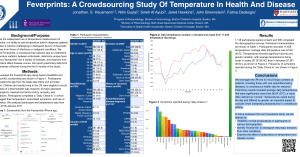
Background/Purpose:
Despite the widespread use of temperature measurement in healthcare, our ability to use temperature data to diagnose patients is limited; it remains challenging to distinguish fevers of rheumatic illnesses from those of infectious or malignant conditions. We created Feverprints, a crowdsourcing research app to understand temperature variation between individuals, determine unique fever patterns (“feverprints”) for a variety of illnesses, and examine how antipyretics affect disease course. We report preliminary data from temperatures collected during the first 9 months of the study.
Methods:
We developed the Feverprints app using Apple’s HealthKit and ResearchKit; screenshots are shown in Figure 1. Participants downloaded the app from the Apple App Store and provided consent. Children and adults living in the US were eligible to enroll; ownership of a thermometer was required. Surveys assessed demographics, medical and family history, ancestry, and medications. Participants completed a “Daily Check-in” in which they logged their temperature, associated symptoms, and use of antipyretics. We analyzed participant and temperature data from March 2016-January 2017.
Results
1,118 participants signed consent and 685 completed the demographics surveys. Participant characteristics are shown in Table 1. Participants recorded 11,458 temperatures; average daily temperature was 97.8F/36.5C. Temperatures showed significant diurnal and gender variation, with average temperatures being lower in males (97.5F/36.4C) than in females (97.9F/36.6C), as shown in Figure 2. Frequency of symptoms reported during the “Daily Check-in” are shown in Figure 3.
Conclusions
We leveraged the iPhone to recruit large numbers of patients, including those with rare autoinflammatory diseases, to crowdsource health data for research. Preliminary results revealed average daily temperatures that were significantly lower than 98.6F (37C), a value often defined as “normal.” Temperatures varied during the day and differed by gender, an important aspect to consider when interpreting temperatures in a healthcare setting.
In future analyses from our Feverprints study, we will attempt to:
- Redefine normal temperatures in participants of various demographics.
- Identify “feverprints” to distinguish rheumatic diseases from other conditions.
- Examine the effect of antipyretics on temperature and disease course.






